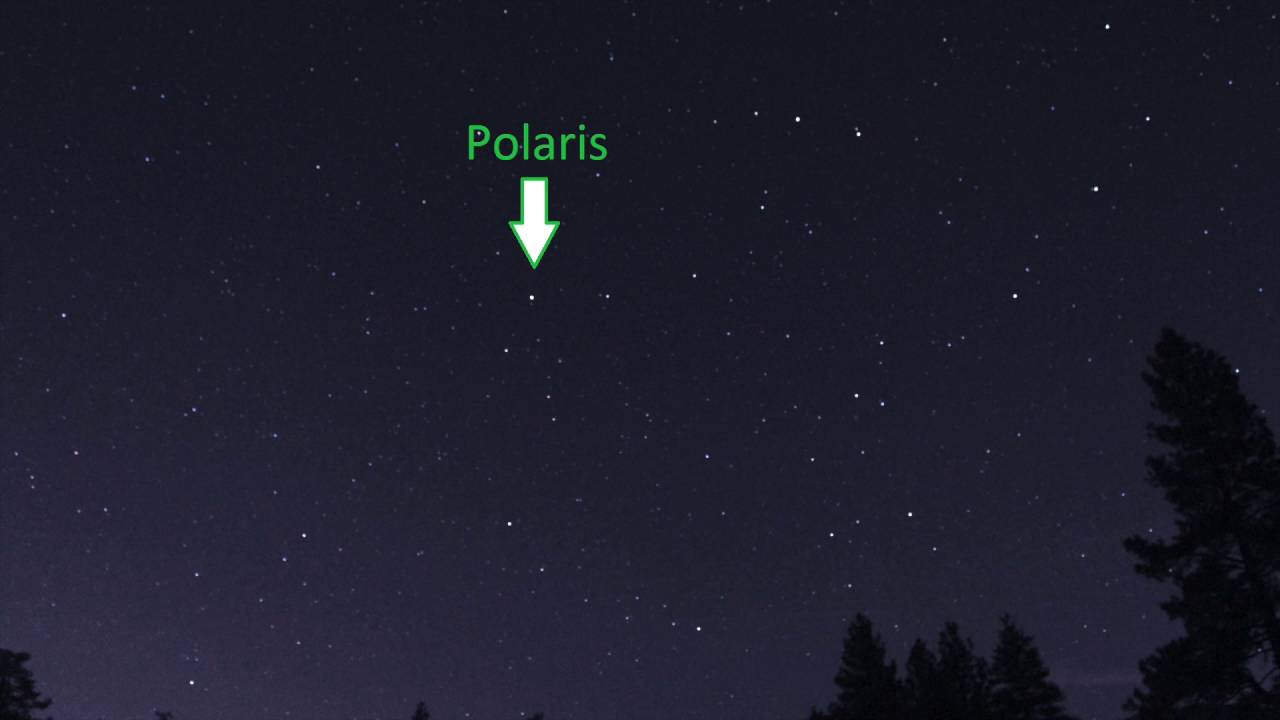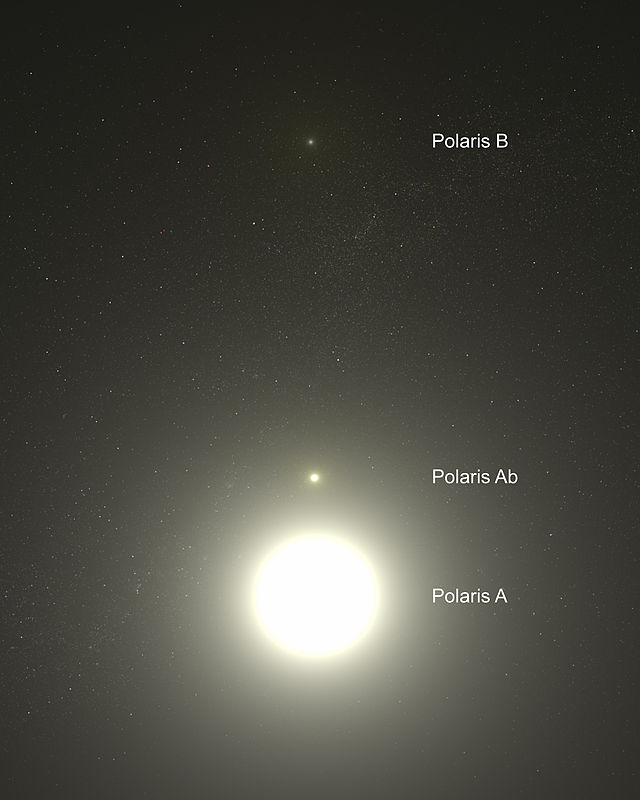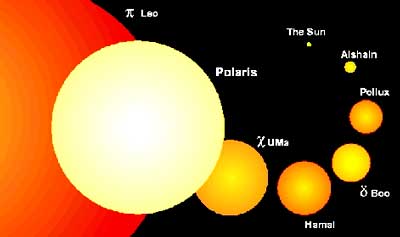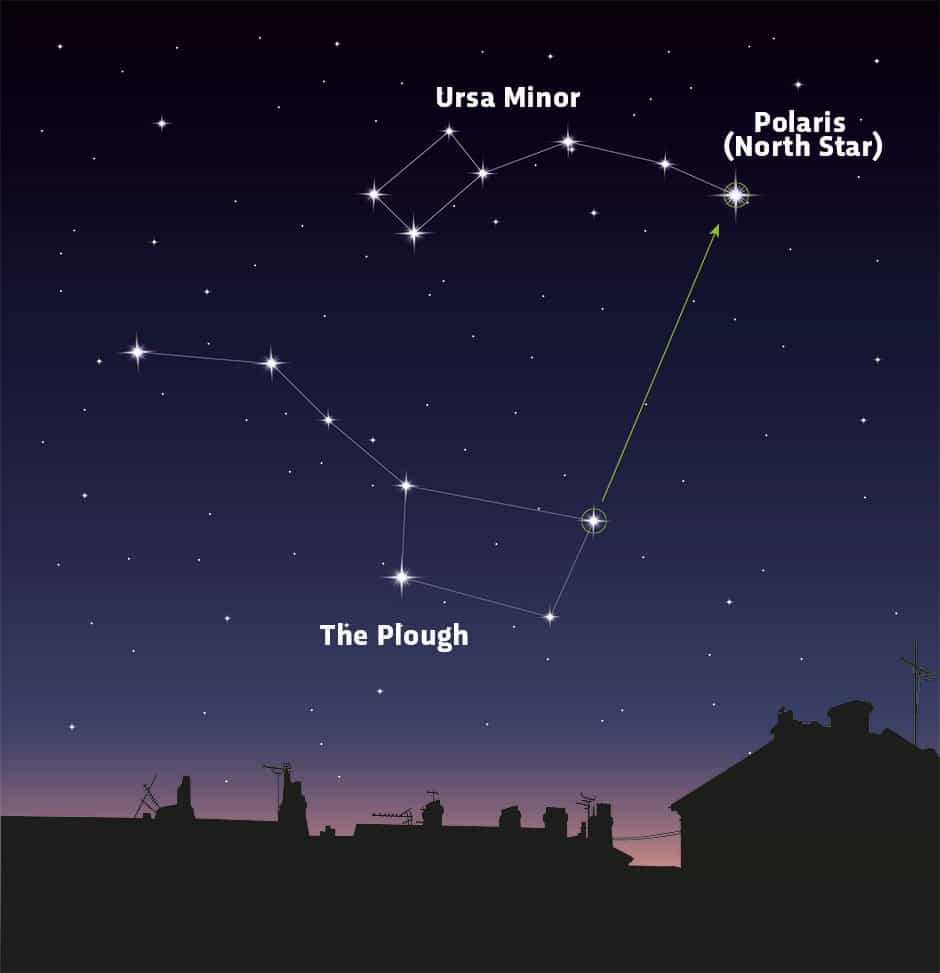Polaris is currently the north star or pole star, and it is the brightest star located in the constellation of Ursa Minor, the little celestial bear.
Key Facts & Summary
- Polaris is located at only 433 light-years / 133 parsecs away from the Earth.
- Even though Polaris appears as a single star to the naked eye, it is actually a triple star system.
- This triple star system comprises Polaris Aa, the primary star, and Polaris Ab, and Polaris B.
- The primary star, Polaris Aa, is a yellow supergiant star of spectral type F7lb.
- The star Polaris Ab is a main-sequence star of spectral type F6V, while Polaris B is a main-sequence star of spectral type F3V.
- Polaris Aa, the primary star, is more massive and several times bigger than our Sun.
- It has around 5.4 solar masses and a whopping 37.5 solar radii.
- Polaris Aa is slightly hotter than our Sun, having surface average temperatures of 6,015 K.
- Polaris Aa is 1,260 times more luminous than our Sun.
- Polaris B is the second biggest planet of this star system, having 1.39 solar masses and 1.38 solar radii.
- On the other hand, Polaris Ab is the smallest, having 1.26 solar masses and only 1.04 solar radii.
- The hottest of these stars seems to be Polaris B, which has temperatures of around 6,900 K.
- Polaris B is also a speedy spinning star, having a rotational velocity of 110 km / 68.3 mi per second.
- Polaris Ab is three times more luminous than our Sun, while Polaris B is 3.9 times more luminous.
- The Polaris star system has an apparent magnitude of 1.98; however, its brightness varies from 1.86 to 2.13.
- The apparent magnitude of Polaris Ab is 9.2, while Polaris B is at magnitude 8.7.
Polaris Star for Kids
Polaris is a triple star system located in the constellation of Ursa Minor, the little celestial bear. It is the brightest star in the constellation, and it is currently our North Pole Star.

The ancients often used North pole stars for navigational purposes, so these stars were very important, and they still are even to this day. Let’s find out more about Polaris, the north star!
Polaris Characteristics
Though Polaris appears as a single star to the naked eye, it is actually a triple star system composed out of a yellow supergiant star and two considerably smaller main-sequence stars.
Polaris is located at around 433 light-years / 133 parsecs away from the Earth. Polaris Aa, the primary star, is slightly hotter than our Sun, having surface average temperatures of 6,015 K; however, it is 1,260 times more luminous than our Sun.

The hottest of these stars seems to be Polaris B, which has temperatures of around 6,900 K. Polaris B is also a speedy spinning star, having a rotational velocity of 110 km / 68.3 mi per second.
Polaris Ab is three times more luminous than our Sun, while Polaris B is 3.9 times more luminous. The Polaris star system has an apparent magnitude of 1.98; however, its brightness varies from 1.86 to 2.13. The apparent magnitude of Polaris Ab is 9.2, while Polaris B is at magnitude 8.7.
Formation
The Polaris star system formed around 70 million years ago from an interstellar medium of gas and dust. Gravity pulled the swirling gas and dust together and resulted in the brightest star in the constellation of Ursa Minor, Polaris, and its two smaller companions. Later on, Polaris would become the north pole star of our Earth.
Fun Kids Facts About Polaris – The North Pole Star
- Though it is quite bright, Polaris is actually the 50th brightest star in the night sky.
- If you want to find Polaris, you first have to locate the Little Dipper asterism.
- If you draw a line between the stars Dubhe and Merak and extend it about five times, you will find Polaris.
- Polaris won’t always be our North pole star. In the year 14,000, Polaris will be replaced by the star Vega, as the north pole star.
- Polaris is even more accurate than a compass, indicating the true north.
- Polaris B can be viewed through a telescope. This star was discovered in 1780 by astronomer Sir William Herschel. Only one year later, Herschel discovered the planet Uranus.
-The third star in the Polaris star system was discovered in 1929.
- The stars Dubhe and Merak seem to follow Polaris in the sky. They are known as the “Guardians of the Pole” since they seem like sentries.
Size and Comparison
The primary star Polaris is more than 50 times bigger than our Sun, and it is more massive. Polaris has around 5.4 solar masses and 37.5 solar radii.

Star System
The two stars orbiting Polaris are very small in comparison, but they are both bigger than our Sun. Polaris Ab has around 1.26 solar masses, and 1.04 solar radii. It is around 8% bigger than our Sun.

Polaris B, on the other hand, has 1.39 solar masses and 1.38 solar radii. It is thus around 60% bigger than our Sun. Polaris B is the most distant in this star system, orbiting the others at a distance of 2,400 AU. One AU is the equivalent of the distance between Earth and the Sun.
Trivia
What is Special About the Star Polaris?
Polaris is special since it is one of the few stars that get to be the north pole stars once every many years.

The north pole star is very important since it can be used for navigation, and it is even more accurate than a compass, indicating the true north. Polaris marks the true north, and it will do so for many years to come.
How Long Will Polaris Be the North Star?
Polaris will be our north star for around 13,000 years. It is currently the closest star to the north celestial pole, and in the year 14,000, Polaris will be replaced by the star Vega as the north pole star.

Why is the North Star so Bright?
The north star is usually perfectly situated directly over the Earth’s northern axis, and it never sets. It appears stationary to the naked eye, and this perhaps contributes to its bright appearance, or illusion of brightness.
How Accurate is the North Star?
The north star is more accurate than a compass; however, it is still a little offset, by about three-quarters of a degree from the celestial north. Even so, Polaris can easily be used for navigation.
Polaris Star Notes
- Polaris is the current north pole star, indicating the true north even more accurately than any compass.
- To the naked eye, Polaris appears as a single star, however, it is a triple star system composed out of a supergiant yellow star, and two smaller main-sequence stars. These smaller stars are however, bigger than our Sun.
- Polaris is the brightest star in the constellation of Ursa Minor, and the 50th brightest star in the night sky.
- Polaris will be replaced by the star Vega as the north pole star in the year 14,000. Vega itself will be replaced, and this cycle will go on and on.
Sources:
Image Sources:
- https://i.ytimg.com/vi/wwtE2QzxND4/maxresdefault.jpg
- https://cdn.mos.cms.futurecdn.net/3EydFhEfXqgtRF7FSwvN8F-1200-80.jpg
- https://upload.wikimedia.org/wikipedia/commons/thumb/7/77/Polaris_system.jpg/640px-Polaris_system.jpg
- https://spaceflightnow.com/news/n0006/10polaris/illustration.jpg
- https://images.immediate.co.uk/production/volatile/sites/4/2020/06/GettyImages-466605914-with-annotation-99f7120.jpg?quality=90&resize=940,973
- https://skyandtelescope.org/wp-content/uploads/Precession-panel-ST_edited-2.jpg
